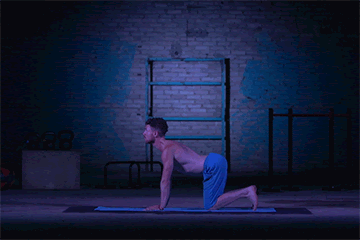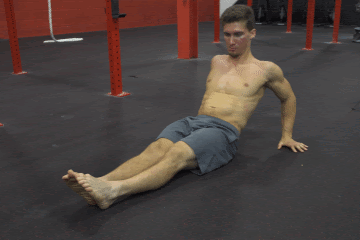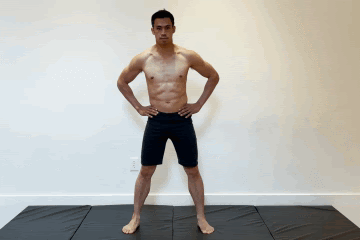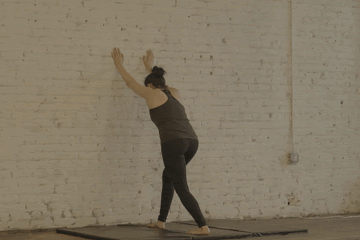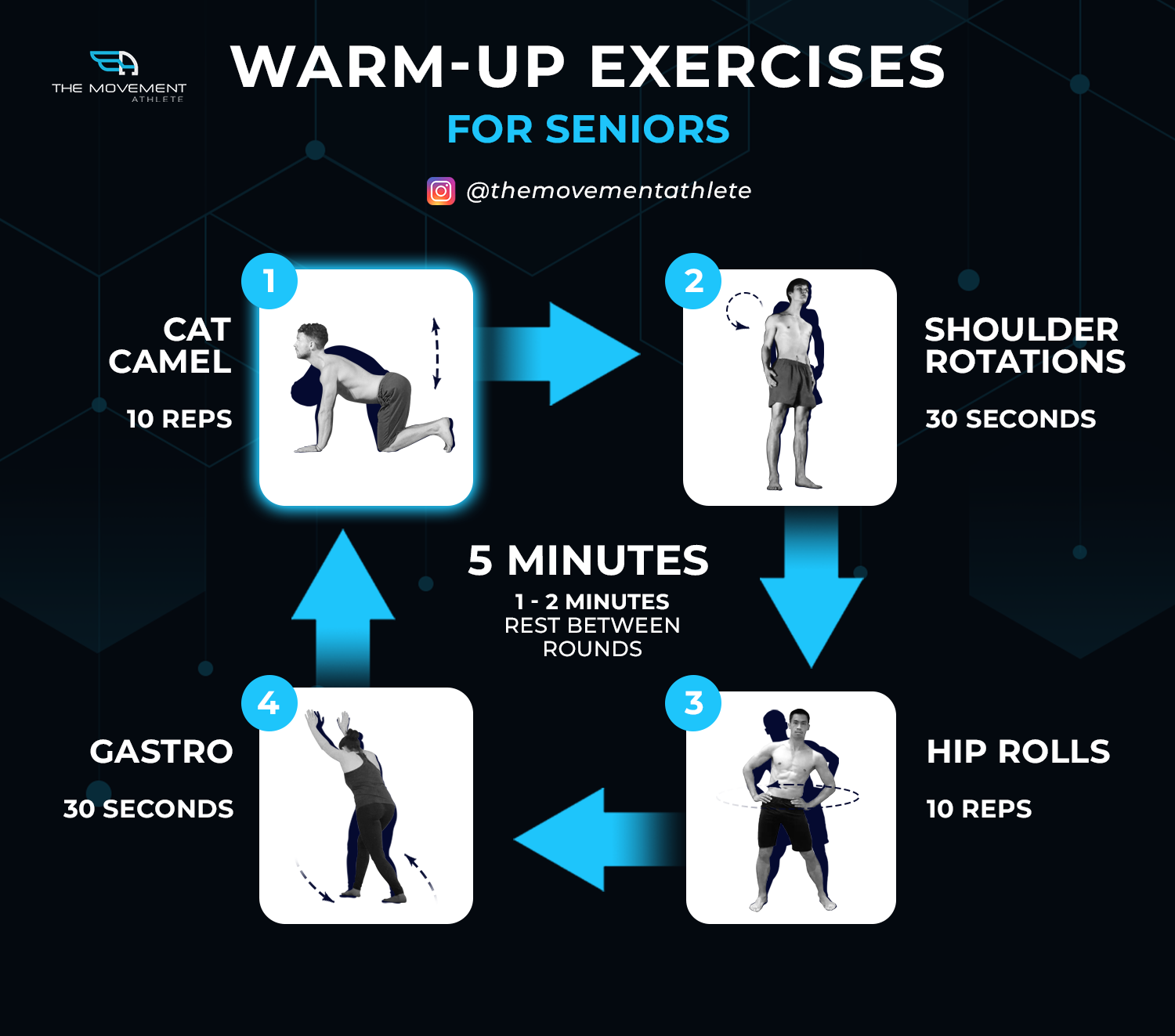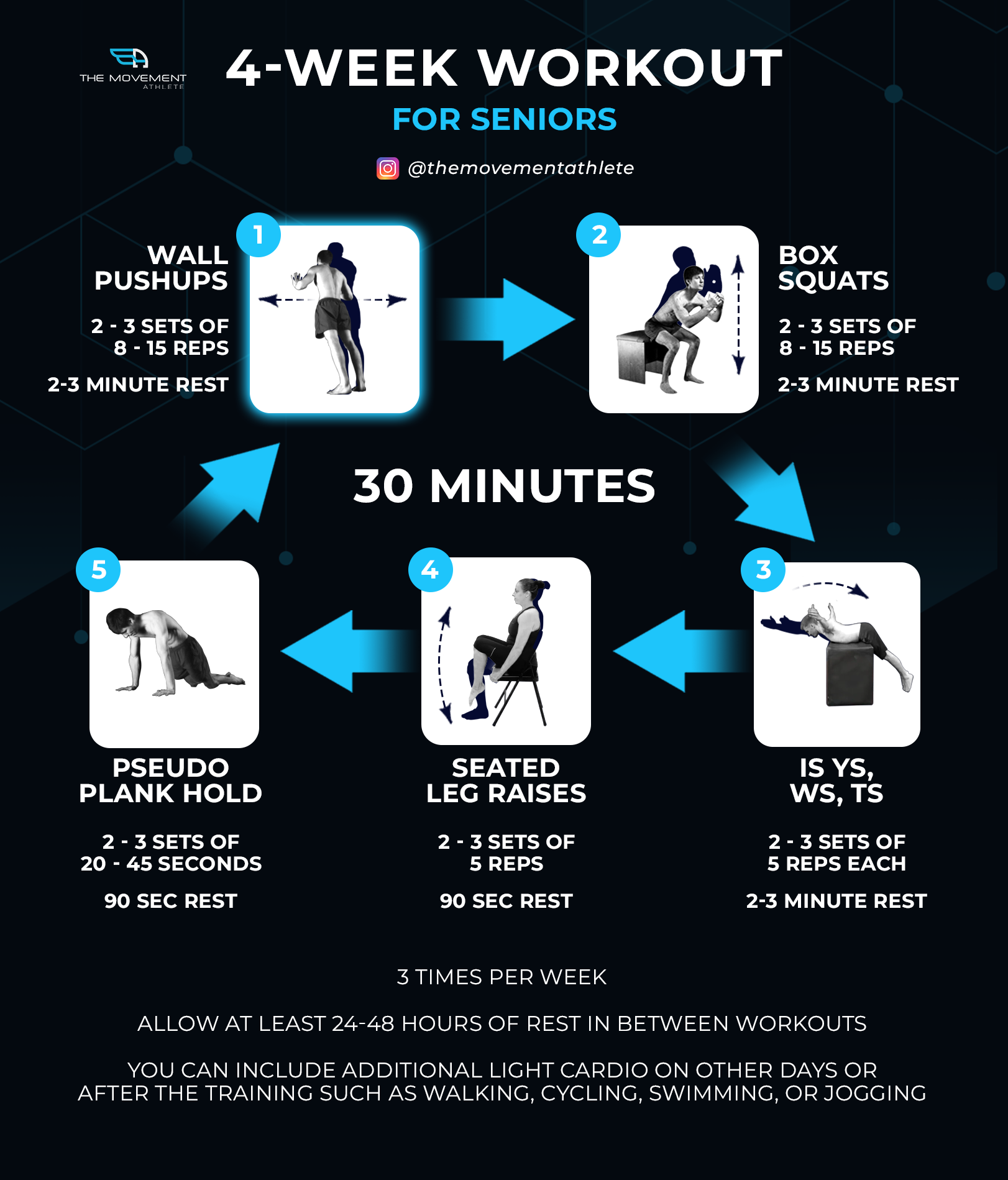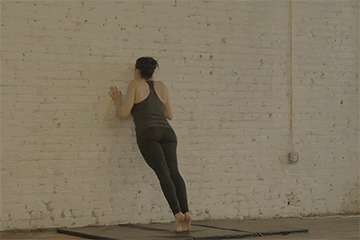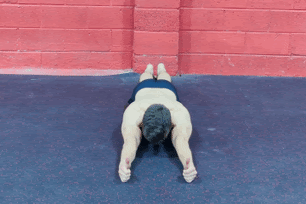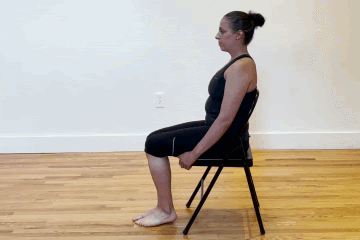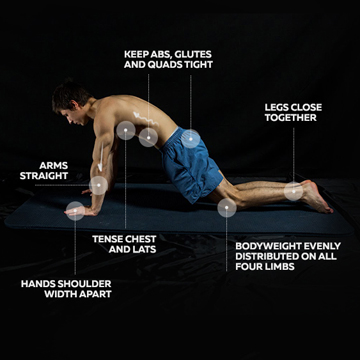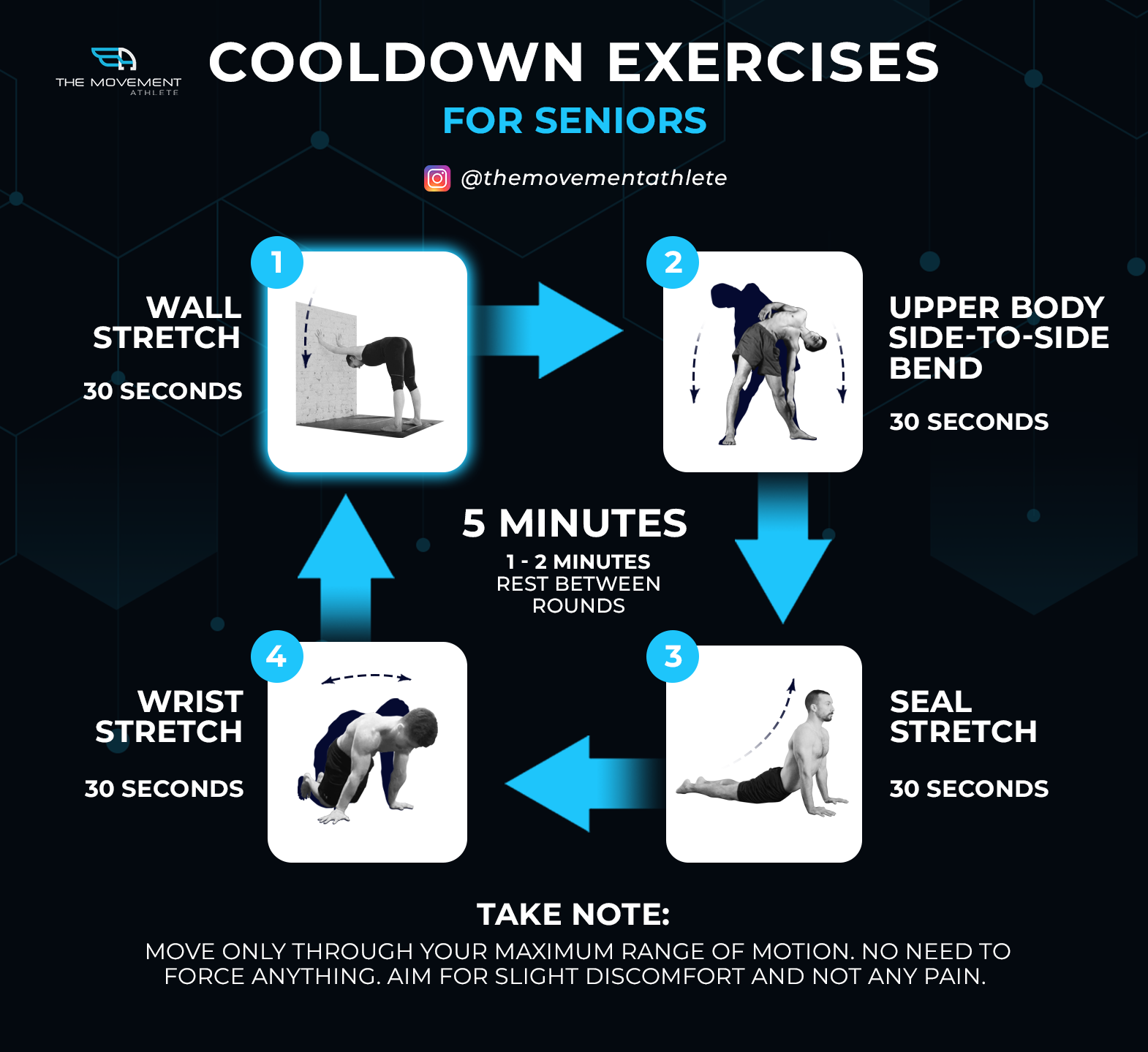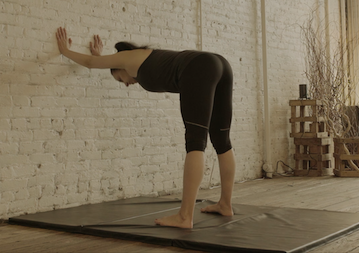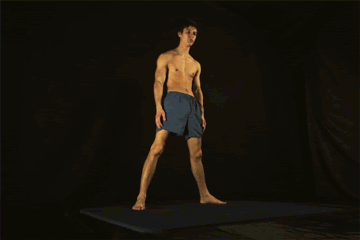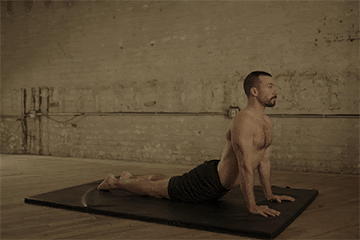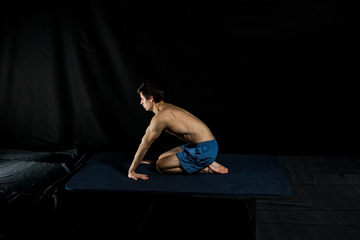Age is not an excuse – keep getting stronger over the years!
As we age, our bodies change and we may find that it becomes more difficult to stay in shape. This is why calisthenics exercises are a great option for seniors – they can be done without any equipment, and they are low-impact so they won’t put too much strain on the body. In this article, we will discuss the calisthenics workout for seniors without equipment that can help keep you fit and healthy! We’re covering the following topics below:👇
- 🏆 What is calisthenics
- 🏆 Common concerns for seniors when working out
- 🏆 Why you should workout when you grow older
- 🏆 Why you should opt for calisthenics training with no equipment
- 🏆 The full-body calisthenics workout
- 🏆 & frequently asked questions about seniors when working out
🤔What is Calisthenics?
Calisthenics is a form of resistance training that uses your own body weight as resistance. It’s similar to weightlifting wherein your primary goal is to build muscle and get stronger, but unlike with weights, you don’t need external resistance (dumbbells, barbells, machines). This makes calisthenics a great option for those who don’t have access to weights or other equipment.💯
Calisthenics has been around for centuries – it was used by the ancient Greeks to train their athletes/soldiers for battle. Today, calisthenics is still used by military personnel and law enforcement officers as a way to stay in shape and build muscle. It’s also become increasingly popular with civilians as a form of exercise that can be done anywhere, anytime.
Although calisthenics has been existing dating way back, it’s not as popular as its weightlifting counterpart. This is because calisthenics is not that marketable since there is only a little equipment needed and you can do it anywhere (MAJOR ADVANTAGE FOR US!) We highly recommend taking advantage of the accessibility of calisthenics even for seniors.
☝️Common issues for seniors and exercise
Let’s face the reality that our bodies change over time and that’s not necessarily a bad thing. It’s an opportunity for new growth! But many older adults have some reservations about exercise and that’s only natural.
Here are just some of the concerns that you might be thinking of:
“Am I too old for exercise?”😱
Are you too old to improve your health and fitness level? No! It’s never too late to work on yourself. In fact, you’re at an age when you need to do more exercise to “reverse” the effects of aging. Osteoarthritis, back and neck pains, and weak knees aren’t effects of aging. Sure, you might be more susceptible to these conditions, but evidence suggests that it’s because of the LACK OF MOVEMENT AND PHYSICAL ACTIVITY.
If you don’t want to experience the “said effects” of aging, then you need to keep on moving. If you don’t use it, you will lose it. Keep using the muscles and joints so you can maintain your body’s capabilities of movement.
👇Here are some stories of Movement Athletes’ at a later age but still making massive gains!
- ” I never felt as good as I do now, EVER! I can keep up with my kids and grandkids!” – BJ, 57
- “I tried different calisthenics programs, but I kept getting injured. Now I know it’s the lack of personalization that [TMA] addresses. I absolutely love the program! – Donald, 65
- “…continuity is the key to success.” – Martin, 51
Another example of working out over 60s
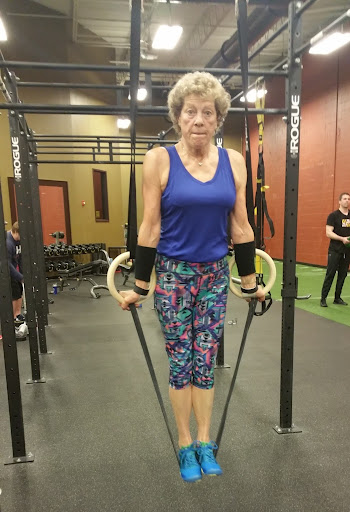
Carol on a solid assisted ring support hold with a full turnout!
Carol’s a 68-year-old fitness enthusiast who stopped training after 5 years because of a lack of progress. This got her frustrated and made her gain some weight. After getting introduced to calisthenics and The Movement Athlete, she finally got stronger and fitter than ever. She can even perform📍 dips on gymnastics rings!
This shows that it’s never too late to train no matter the age.
Read more on Carol’s story here: 📍How Carol is 68 and Got Stronger Than Ever with Calisthenics
“I haven’t done any workout for years?”🥺
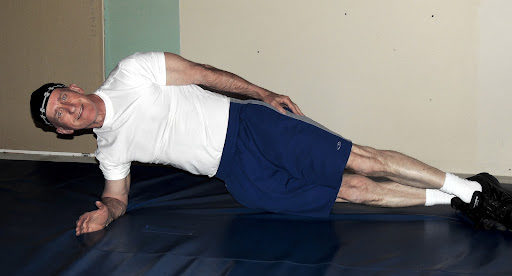
Donald at 65 rocking a side plank hold with solid form!
This is quite similar to the concern above. Whether you’re a complete beginner or someone advanced who stopped for years, it’s never too late to get back on exercise. You can always adjust a workout based on your skill level.
That’s why with The Movement Athlete app, we focus on providing a personalized approach to training. This keeps your workout suitable to whatever skill level you’re in. Even if you’re a beginner, there is a ton of spectrum within the beginner level with varying strengths and weaknesses.
In this workout program, we opt for the beginner side which you can further progress to a more advanced variation once you gain more strength. Calisthenics is 📍progressive and can be scaled to your current state. Continue training and progress GRADUALLY.
“Can I work out even with Arthritis? “😢
There are different types of arthritis and each varies from the other, but the common ground is the swelling or pain of the joints. Should this stop you from training? No.
In fact, several studies (study 1, study 2, study 3, study 4, study 5 ) suggest that exercises, whether it’s resistance training like calisthenics or aerobic training, promote joint development that can alleviate pains caused by arthritis.
The stronger your joints and muscles can be, the better your condition will be grated that your current is properly assessed first by a medical practitioner.
“I have aches, pains, and some past injuries.”🤕
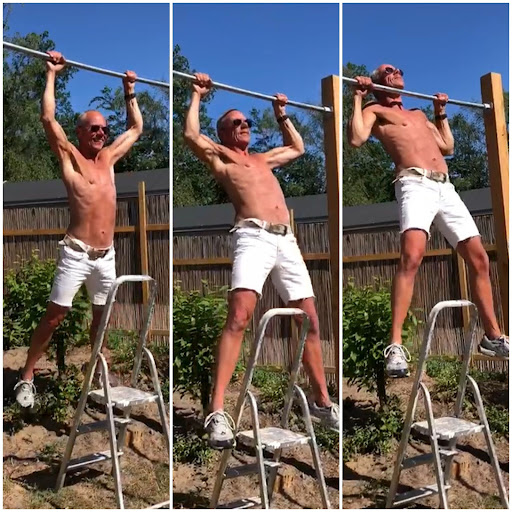
Stijn is now pumping pull-ups even after battling a neurological condition.
Do you know what calisthenics can be used to treat injuries? Aches and pains are manifestations that there is an existing dysfunction in your body. These pains are telling you that there’s something wrong in your body that needs fixing.
While getting complete rest sounds like the logical option, it’s actually counterintuitive especially if the main cause of your pain is lack of movement.
Calisthenics is a natural movement which means exercises follow how should our bodies actually move. Using these movements will help rebuild your body from the injuries so you can get back on track with a healthy, fit body.
Read more here: 📍How to Treat Injuries with Calisthenics
Examples of pain recovery stories👇
- “I thought I made some progress lifting weights. After training with [calisthenics], you realized how weak and immobile you are.” – Mark, 54
- “Movements that used to injury me, NOW I can do pain-free.” – Andrew, 29
- “I was looking forward to [The Movement Athlete training] every day! I had to restrain myself sometimes.” – Stijn, 54
- “… I had lower back problems for all my life. Now I don’t know what lower back problem is!” – Kristian, 39
But before you go on doing calisthenics, the first step is ALWAYS to consult with your specialist in person to get an accurate diagnosis of your current situation and condition. Don’t rush!
🧐Why you should work out as you grow older
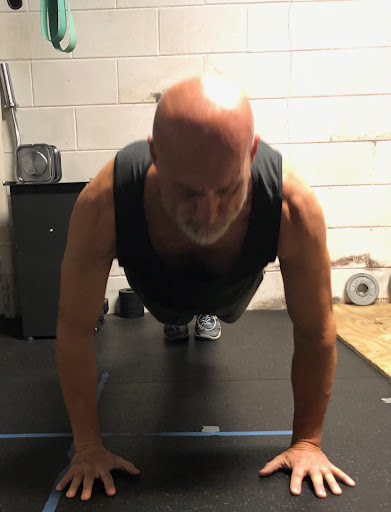
Movement Athlete Mark doing push-ups easily at the age of 54
There are plenty of reasons why you should still be working out and moving even as you grow older. It’s not about maintaining a six-pack, but more about taking care of your aging body so you can maintain the feeling of strength and control over your body.
Delays and prevents muscle💪 loss and bone🦵 weakness
As we age, our bodies go through a lot of changes. We slowly lose muscle mass and our bones become weaker. This is commonly called sarcopenia or the age-related loss of muscle that starts as early as 30 years old!
However, a recent 2021 meta-analysis has shown that progressive resistance training is an effective treatment to prevent muscle loss while building up muscle, lowering body fat, and increasing muscle strength and performance.
Resistance training like calisthenics stimulates anabolic hormones that promote muscle growth and prevent muscle loss regardless of age. This is extremely beneficial especially as we age since muscle loss is one of the main reasons why we become weaker.
Not only does calisthenics help with muscle growth, but it also strengthens bones. In a study done on postmenopausal women, they were put into two groups: those who did calisthenics and those who didn’t. The calisthenics group saw an increase in bone mineral density while the other group’s density remained the same. This means that the risk of key fractures and bone loss is prevented.
🤯Improves cognitive function
Cognitive decline is a natural part of aging. It’s possible to get slower reaction time, difficulties in retaining attention, lower sharpness, and difficulty in memorization. However, there are things we can do to slow it down. One of them is working out! Yes, physical development through physical activities can help improve our cognition even at later ages.
💊Delays and prevents diseases
Aside from the well-known benefits of calisthenics like weight loss and improved muscle and bone strength, calisthenics can also help delay and prevent chronic diseases.
As we grow older, the risk of developing or contracting diseases tends to increase. However, a study done on elderly men showed that those who did exercises had a lower risk of developing cardiovascular diseases than those who didn’t. Exercise improves our blood circulation and lowers our blood pressure, both of which are important in keeping our heart healthy.
🏃Keeps you moving
If you have any other hobbies (that are not even physically demanding) such as gardening, swimming, dancing, or if you want to move on your own without the assistance of anyone, then you better keep moving.
Exercise, ideally a combination of strengthening exercises and aerobic training, translates to a better everyday life. Working out can help you improve everyday movements as simple as walking and standing which can get negatively affected as you age IF you don’t maintain a level of physical activity.
Even if you’re not aiming to maintain a Greek god’s body after your 50s, exercise has too many benefits for you to pass on this type of activity. Keep on moving so you can keep on moving in later years.
Read more here: 📍What Does It Mean to Be Strong in the Real World?
👀Better mind and body
Improving your fitness level can also enhance your mood and mental state. In one study, it was shown that just 30 minutes of exercise improved the mental state of participants. They had better focus, energy, and motivation after their workout session. There was even a study that show that a single training session can positively impact pre- and post-workout sessions.
Calisthenics also releases endorphins or “happy hormones” that can improve your mood and make you feel good. Not to mention the fact that exercise can help reduce stress and anxiety. So if you’re looking for a workout that will not only make your body better but also your mind, calisthenics is the way to go!
🤸Let’s you enjoy with your family more!
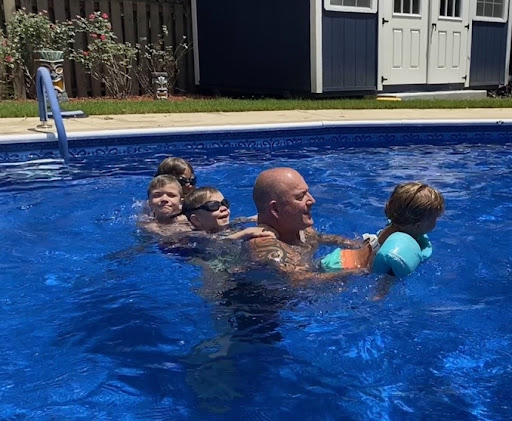
57-year-old BJ enjoying his time with his grandkids with ease.
Some people get inspired to take care of and bonding with their families. Exercise lets you improve your health and fitness level so you can keep on taking care of your family. Working out with your family, especially if it’s done in your home with calisthenics, is another way you can bond with them more.
Why does calisthenics work for seniors?😍
Now that you have an overview of why should older adults needs exercise, let’s talk about why you should consider calisthenics as your training approach.
Disclaimer: While we are hardcore calisthenics enthusiasts, we don’t look at fitness from a black and white perspective. Calisthenics might fit you, but it’s also something you may not like. Always opt for the exercise that fits your needs and goals, that you enjoy, and that you can do consistently.
Read more here for: 📍When is Calisthenics NOT for you
There are a lot of methods you can choose to improve your health and fitness levels, but calisthenics does offer some advantages that you might want to look into.
👊Advantage 1: You can train anywhere or at home at anytime
One of the main advantages of calisthenics compared to any other training regimen is CONVENIENCE. There’s no need to go to the gym or look for a calisthenics park. You can do bodyweight training in your regular parks, at home, in a hotel, during your break in your office, anywhere!
This is also the reason why you can definitely see significant progress with calisthenics. Because it’s so convenient, you can easily commit to your workout even if you’re constantly traveling like one of our Movement Athletes, Anthony, who’s a pilot.
Read more: 📍How Anthony Stayed Fit While Travelling the World as a Pilot
👊Advantage 2: 0 to minimal equipment needed
The reason why you can train anywhere at any time is the minimal use of equipment. With bodyweight training, your resistance mainly comes from… your body weight.
But it’s best to train with a least SOME equipment that’s fairly affordable and accessible. The best ones you want are:
- pull-up bar
- dip station
- a set of resistance bands
- gymnastics rings
That’s all you want. You can search for alternatives in your surrounding, but you just have to stay a bit creative. Check out our article below if you need additional help with this topic.
📍The Ultimate Guide to Calisthenics Equipment and Cheap Ways to Replace them
👊Advantage 3: Holistic development
Calisthenics is a comprehensive approach. It’s not just about bodyweight raw strength. If you lack mobility, flexibility, endurance, body control, body awareness, and balance, then it will show when you perform calisthenics exercises. Bodyweight exercises target the whole body and help you improve holistically.
👊Advantage 4: Minimal risk of injury
A common concern with senior exercise is the risk of injury. To be fair, all movements have a risk of injury even if you’re young or a bit more “experienced” in life. However, this risk is controlled with calisthenics since you’re only using your body weight and nothing more. You can even minimize the risk if you stay smart with your training by:
- Learning first proper exercise form
- Performing warm-ups
- Using appropriate exercises and suitable progressions
- & staying patient by gradually progressing
For a complete guide on injury prevention, check this article: 📍How to Avoid Injuries When Training Calisthenics
👊Advantage 5: Always targeting the core
Core strength isn’t just about having 6-pack abs. It’s about having a strong trunk that can help in stabilization and mobilization. A strong core helps further reduce the risk of injuries and promotes stronger performance.
The good news, calisthenics is a fantastic core-builder since most compound calisthenics exercises train the core. And the bodyweight core exercises are safe, functional movements that translate to better core control.
If you’re still not yet convinced with the calisthenics approach, then maybe you need a little bit of a push. Read more: 📍Is Calisthenics Really a Better Way to Train?
👊Advantage 6:Heavy focus on mobility training
What is mobility and why is it important? Mobility is basically moving through a range of motion with complete control of your joints and muscles. It sounds like flexibility but there is a small difference.
With mobility, you move through the range actively.
With flexibility, you hold the end range passively either with your hands, the floor, gravity, weights, or training partner.
Mobility training has more transfer to real-life movement because you can use the strength you gained through a wider range of motion.
This is why people tell that calisthenics offers functional strength. It is essential that you use your strength in a way that your body is supposed to use it, and that is through mobility. In addition, more mobility means fewer aches, pains, and stiffness!
👊Advantage 7: Strengthens the joints
Another advantage of mobility training and calisthenics strength training is joint development and preparation. Many calisthenics exercises hit surrounding muscle groups around the joints efficiently to better prepare them for other movements.
Stronger joints mean no aches and pain over the years. It also gives you the freedom to move freely even as you age.
Calisthenics, in nature, is a holistic approach which is why it’s perfect for joint development training. No lagging muscles as well that can potentially cause aching joints!
👊Advantage 8: Progressive at a steady pace
In weightlifting, progress is very straightforward since you only have to add reps and sets or add weights to the same movement pattern you’re working on.
With calisthenics, it’s slightly different, but both approaches are naturally progressive that can induce strength and muscle growth.
In calisthenics, you can achieve progressive overload by implementing progressive approaches such as:
- Using progressions – A set of exercises that gets harder towards the main skill you’re working on
- Adding reps & sets
- Decreasing rest time
- Varying exercise tempo
- & even adding weights to calisthenics exercises
You can read more on 📍Progressive Calisthenics, here.
But progressive calisthenics is not enough to make your progress safe and optimal especially as you’re getting older.
🤜Assess your current skill level
The number one reason why many people are frustrated with their workout because of lack of progress or getting injured is not performing a workout routine that suits their current abilities.
On one hand, overestimating your skills can lead to injuries. You might be doing too much training volume or performing an exercise that you can’t perform with good form; hence, injuries can occur.
On the other hand, you might be underestimating your strengths which can make do a workout that’s not stimulating enough to promote growth.
Understanding your body’s strengths and weaknesses is the best first step you can take so you can get a proper workout that will suit your optimal development.
TAKE A SHORT ASSESSMENT NOW!
🤜Personalised training
Once you have evaluated your capabilities, the next best thing is to find a training program that can suit your specific strengths and weaknesses. This is what The Movement Athlete is all about. It challenges the more popular 📍one-size-fits-all approach to fitness that can be doing more harm than good to your body.
🤜Adaptive workouts
As aging individuals, you need to take a smarter approach to your training. Pushing hard doesn’t mean you have to give out your 100% all the time. Especially since you have other responsibilities that can take up your physical, mental, and emotional energies,
This is where adaptive training comes in by following the principle of auto-regulation. In addition to how The Movement Athlete app structures its personalized programs, your program should also adjust to what you can give in your workout.
🤜Sustainable workouts
Training with 101% of your effort isn’t always realistic and sustainable, especially for older adults. Adaptive training keeps you pushing just enough for growth while not overdoing it so you can keep on going in the long run.
Fitness is not a race. It’s a lifelong marathon so keeping it more consistent little by little is A LOT BETTER than pushing hard for just a few sessions.
⚡️Disclaimer: Training the smart way for seniors
🩺Check your current condition
It’s always better to be safe than sorry. If you have an existing or past condition, it’s always best to consult with your healthcare specialist in person. Don’t consult online as this can only give you an inaccurate diagnosis.
Checking with your specialist helps you identify possible restrictions and limitations. It can also help you know if you have pains that could potentially hinder OR potentially get cured with calisthenics training. You will not lose anything when you ask.
♥️Watch your heart rate
Like other qualities and bodily functions, aging also affects your heart’s rate of pumping blood during physical activity. This means that you are more prone to overloading your heart too much when performing a vigorous exercise.
Below is a chart of your ideal heart rate when working out as recommended by the American Heart Association.
You don’t want to be pushing close to your maximum heart rate as this can be dangerous that you’re straining your heart too much. Progress conservatively. There’s nothing wrong with pushing yourself, but you have to do it in a smart, sustainable fashion.
💧Look out for dehydration
If you don’t get enough water in you, you can get dehydrated which can negatively impact your training performance, and cognitive abilities, and even turn into a cramp, dizziness, early fatigue, or even injuries.
Drinking water shouldn’t only be done during your workout. Drink water regularly as it also serves your body for other functions, not just for your upcoming sweat-inducing training. The National Academy of Medicine recommends around 9-13 cups of water (8oz per cup) throughout the day. You can increase the number when you’re performing your workout.
👍Cat camel – 30 seconds
👍Shoulder rotations – 30 seconds
👍Hip rolls – 10 reps clockwise and counter-clockwise
👍Gastro – 30 seconds for each leg
🏆Full-body Calisthenics Workout for Seniors without Equipment
Warm-up
📍The Ultimate Guide to Calisthenics Warm-up
👊4-Week Workout for Seniors👊
- 3 times per week
- Allow at least 24-48 hours of rest in between workouts
- You can include additional light cardio in other days or after the training such as walking, cycling, swimming, or jogging
🎯 Wall push-ups
2 – 3 sets of 8 – 15 reps
Developing upper body strength is necessary for daily function in everyday life. Push-ups will never fail you. However, the regular floor push-ups might be too difficult for most seniors without a fitness background or who has been on a long training hiatus. The wall push-ups keep the intensity minimal while still allowing growth for the upper body muscles such as the chest, triceps, shoulder, and even your core.
How to perform:
- Begin standing in front close to a wall.
- Put your hands on the wall with shoulder-width apart slightly lower than shoulder level.
- Extend your arms straight and step backward so that your body is diagonal. This is the starting push-up position.
- Lower down with control by bending your arms and leading your chest to the wall until it nearly touches it.
- Push back up to the starting position.
- Repeat for reps.
Coaching pointers:
- Keep your arms straight every reset to the starting position.
- Maintain your elbows tucked close to your body
- Engage your core
- Tilt your hips backward
- Straight bodyline
- Press down your shoulders as far away from your ears
- Pinch your shoulder blades together as you lower down
- Move with control
- Keep your weight unto your hands
Easier: Stay more vertical with your body to shift some of the weight unto your legs
Harder: Move into an incline position by moving to a lower elevated surface, knee push-ups
🎯 Box squats
2 – 3 sets of 8 – 15 reps
Box squats or chair squats are a variation of bodyweight squats that limits your range of motion thanks to the box or chair behind you. This exercise strengthens your whole lower body complex such as your glutes, quadriceps, hamstrings, calves, ankles, joints, and hips. It’s the perfect lower body exercise to build strength, muscle, and mobility at the same time.
How to perform:
- Set up a box or a chair.
- Position your body close to the chair as if you’re going to sit down.
- Stand with an upright and straight body.
- Raise your arms in front of you for counter-balance.
- Lower your glutes down towards the chair until you are sitting down, but place your weight on your legs so that you’re not actually sitting down on the chair.
- From the sitting position, drive your heels to the ground to push back up to the starting position.
- Repeat the squatting motion for reps.
Coaching pointers:
- Keep your upper torso upright with good posture and a proud chest position
- Feet are around shoulder-width apart but it depends on your preference and comfortability
- Let your knees go past your toes if your mobility permits. There’s nothing wrong with that.
- Core engaged
- Lead with your hips downward
- Controlled movement
Easier: Hold on a piece of furniture, someone, or a wall for assistance, elevate the chair or box to limit the range of motion
Harder: Slower tempo, use a lower chair or box
🎯 Is Ys, Ws, Ts
2 – 3 sets of 5 reps each
It’s time to work on your posterior chain. While it’s ideal to work on row motions such as an easy pull-up variation or bodyweight rows, you can still train the back muscles using this set of movement patterns.
This exercise has 4 shapes which you can do after each set. It targets all the posterior chain but moving the arm position shifts the emphasized muscle groups to a certain degree.
- Is – Upper traps
- Y’s – Lower traps
- W’s – Rhomboids
- T’s – Rear deltoids & middle traps & lats
How to perform:
- Lie on a floor with your stomach facing the floor.
- Make a gap between the floor and your stomach by tilting your hips backward.
- Place your arms overhead.
- Raise your arms upward simulating the current variation you are currently performing: the I’s, Y’s, W’s, or T’s,
- Pause at the top position.
- Lower down with control.
- Repeat for reps.
Coaching pointers:
- Engage your core by tilting your hips backward. This creates that space between your stomach and floor and helps you engage the core. We called this the posterior pelvic tilt which is the position used for push-ups, pull-ups, planks, and many other calisthenic moves
- Move only where your mobility permits
- Movement can be uncomfortable but should not be painful. If any pain exists, use a variation that you can do or elevate lie down on an elevated surface instead
- Move with control and aim to pause at the top range
- Keep your head on the floor
- Avoid moving your lower back and upper back
- Turn your thumbs upward
Easier: Limit range of motion, elevate your body on the edge of a table, do standing with your back against the wall
Harder: Higher range of motion, weighted
🎯 Seated leg raises
2 – 3 sets of 5 reps
Hip problem is another common concern for older adults. Seated leg raises solve this concern while also improving your core, quad strength & mobility. You can do it anyway and all you need is a comfortable, sturdy chair.
How to perform:
- Begin by sitting on a chair with a good upper body posture.
- Drive one knee upwards towards your chest with control.
- Lower down.
- Repeat for reps then repeat for the other leg.
Coaching pointers:
- Engage your core
- Move through your current mobility
- Keep your body upright
- You might feel the burn on your quads, core, and/or hips which is going to be natural
Easier: Limit the range of motion
Harder: Add a pause at the top position, straighten your leg
🎯 Pseudo plank hold
2 – 3 sets of 20 – 45 seconds
As mentioned earlier, core strength is crucial for many physical activities and daily performance. While most calisthenics exercises already hit the core, it’s vital to put in some additional work on your core. The knee plank is an anti-extension exercise that strengthens the core’s ability to resist movement when needed. Anti-extension is one of the main functions of the core which is why it’s vital to directly work on it with planks.
How to perform:
- Go down on all fours on the floor with your arms shoulder-width apart and straight.
- Put both of your knees on the floor.
- Extend your hips so that your body is straight from the upper torso until the knee.
- Hold the position for a specified time.
Coaching pointers:
- Posterior pelvic tilt
- Press your shoulders away from your ears and down
- Maintain straight arms
- Engage your core
- Breathe
Easier: Elevated inclined arms
Harder: Extended leg position
Cooldown
Take note: Move only through your maximum range of motion. No need to force anything. Aim for slight discomfort and not any pain.
👉 Wall stretch – 30 seconds
👉 Upper body side-to-side bend – 30 seconds for each side
👉 Seal stretch – 30 seconds
👉 Wrist stretch – 30 seconds for each hand
If this workout is too easy for you, then you can consider moving into a more challenging workout such as this complete beginner workout. Don’t worry. Seniors can also perform this type of exercise granted that their current abilities allow them to sustain the level of activity for an hour.
Get your 📍Calisthenics Beginner Workout!
🧐Frequently Asked Questions:
🔎Where is the mobility workout for seniors?
It’s commonly thought that to build mobility, you need to stretch. And most people think that static stretching (holding a position at the end range for a sustained period) is the only way to build mobility. However, strengthening exercises, if done with complete range and control can also contribute and actually is a high factor for developing mobility.
You can also perform your static stretches during your cooldown sessions for additional flexibility and mobility gains.
🔎What’s the best workout for seniors?
Ideally, the best exercise for anyone, including seniors, is a combination of aerobics (for cardiovascular health) and strength training (for strength and muscular development). But in reality, the BEST EXERCISE IS WHAT YOU CAN PERFORM CONSISTENTLY THAT YOU ENJOY.
Sure, we can recommend calisthenics as your go-to approach (and it may be so!), but you can opt for other fitness approaches that will fit your needs and wants.
American Heart Association recommends at least 150 minutes of moderate activity or 75 minutes of vigorous activity per week. Activities can be as simple as walking, gardening, yoga, or playing with your grandkids.
🔎Is it possible to build muscle after 65 years old?
Yes, building muscle is very possible even after 65 years old as long you continue following the proper protocols to build muscle. Keep it simple:
- Do resistance training with progressive overload
- Get enough high-quality sleep
- & eat nutrient-dense whole foods with a focus on meeting your protein requirement
🔎What is the best way for seniors to build muscle?
While jogging and swimming are good aerobic exercises that can improve your general health, if you want to build muscle you need resistance training with a progressive approach. You can’t develop muscle if you’re not subjecting your muscles to the mechanisms for muscle growth:
- Mechanical tension
- Metabolic stress
- & Muscle damage
In the current research, building muscle involving these factors is not fully understood. We’re not yet sure if how many combinations of these three are optimal for muscle growth. However, it’s sure that you can only achieve these factors through resistance training such as calisthenics or even weightlifting. Choose whichever approach works for you.
🔎Can seniors regain lost muscle mass?
The effects of sarcopenia can be prevented if you follow effective, progressive resistance training. Calisthenics is a powerful approach you can opt for to build muscle. Check out the article below to learn more about this: 📍How to Build Muscle with Bodyweight Training
🔎Can the elderly regain strength?
This is the main purpose of calisthenics: to build strength. In a 2019 study published in the Journal of Strength & Conditioning, individuals who underwent resistance training developed strength even at the age of 50 and above.
You can use weightlifting or calisthenics, whichever you prefer. Both are forms of resistance training that can elicit neutral adaptations producing higher strength output.
🔎Can seniors learn advanced calisthenics skills?
Who says advanced calisthenics skills aren’t for the older adults?!!
To be fair, there are some points there that are worth looking into. If you’re at an age, advanced skills can be dangerous IF you are not strong enough to attempt the move. However, this holds true for everyone regardless of age. You just have to be more careful and make sure that the progression is taken more conservatively.
Remember that since you’re already losing muscle at a faster rate with ages 50+, it’s much harder to develop strength and muscle compared to when learning planche when you were 16.
It’s possible to achieve advanced calisthenics skills even with an age, but the previous background, current skill levels, and condition should be taken accounted.
Here’s a video of an ex-gymnast from the Chinese national team who’s already 51 years old but smashing a full planche ON RINGS!
🔎How can seniors keep their legs strong?
A common issue with seniors is knee joint pain. This usually comes from weak surrounding muscle groups such as the quads, hamstrings, and calves. If you can strengthen these muscles while improving your joint strength, you can maintain your knee health.
More than that, you can also develop strong leg muscles that are capable of movement. Here are the best leg exercises to look for using only your bodyweight:
🔎What exercises should seniors avoid?
While there are claims that mainstream workouts are not ideal for older adults such as bench press, squats with weights, long-distance running, and HIIT (high-intensity interval training), seniors can STILL perform these types of movements as long as the skill level matches the intensity of the workout.
Take Carol’s situation for example. She still trains with gymnastics rings that put heavy demands on her joints, but still gets massive gains without injuries.
Of course, as you grow older, you have to consider your age when aiming for more difficult and high-impact movements. You should progress more conservatively compared to when you were younger. But in general, there are no movements you have to totally avoid, but this is DEPENDING on your current skill level and situation.
📌Takeaway
Calisthenics is a great workout for seniors without equipment to stay fit and healthy! By following an effective, progressive resistance training program, seniors can prevent the effects of sarcopenia and regain lost muscle mass.💯
Additionally, calisthenics can help seniors build strength and learn advanced skills. Finally, calisthenics exercises can help keep seniors’ legs and the rest of the body strong while avoiding knee, shoulder, hip, ankle, elbow, and shoulder joint pain.
While there are some movements that seniors should avoid, this depends on the individual’s skill level and situation. Ultimately, calisthenics is a great workout for seniors of all levels to stay fit and healthy!
If you’re a senior looking to start calisthenics without any equipment, then this workout is a great place to start your journey. For more advanced seniors, there’s nothing wrong with going straight to this workout: 📍Full-body Calisthenics Workout without Equipment
However, we still HIGHLY RECOMMEND following a personalized calisthenics workout that offers a progressive and adaptive approach to training. If you’re looking for the best, then try out The Movement Athlete for Free.
GET YOUR 7-DAY FREE TRIAL OF PERSONALISED CALISTHENICS TRAINING NOW! 📍

